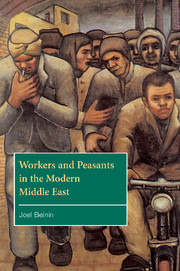Book contents
- Frontmatter
- Contents
- List of tables
- Acknowledgments
- Glossary
- List of acronyms and abbreviations
- Map 1: The Ottoman Empire, 1699–1914
- Map 2: Egypt and Bilad al-Sham
- Map 3: The Middle East in the twentieth century
- Introduction
- 1 The world capitalist market, provincial regimes, and local producers, 1750–1839
- 2 Ottoman reform and European imperialism, 1839–1907
- 3 The rise of mass politics, 1908–1939
- 4 Fikri al-Khuli's journey to al-Mahalla al-Kubra
- 5 Populist nationalism, state-led development, and authoritarian regimes, 1939–1973
- 6 Post-populist reformation of the working class and peasantry
- Notes
- References
- Index
1 - The world capitalist market, provincial regimes, and local producers, 1750–1839
Published online by Cambridge University Press: 03 February 2010
- Frontmatter
- Contents
- List of tables
- Acknowledgments
- Glossary
- List of acronyms and abbreviations
- Map 1: The Ottoman Empire, 1699–1914
- Map 2: Egypt and Bilad al-Sham
- Map 3: The Middle East in the twentieth century
- Introduction
- 1 The world capitalist market, provincial regimes, and local producers, 1750–1839
- 2 Ottoman reform and European imperialism, 1839–1907
- 3 The rise of mass politics, 1908–1939
- 4 Fikri al-Khuli's journey to al-Mahalla al-Kubra
- 5 Populist nationalism, state-led development, and authoritarian regimes, 1939–1973
- 6 Post-populist reformation of the working class and peasantry
- Notes
- References
- Index
Summary
The large-scale economic and political processes that characterize the period of this chapter are the rise of autonomous provincial regimes, the expansion of agricultural production, and the intensification of links between several parts of the Ottoman Empire and the world capitalist market. Although this was a time of political weakness for the Ottoman central government, it was not an era of unmitigated political and economic decline, as traditional Orientalist studies of the eighteenth century maintain (Gibb & Bowen 1950). The political stability and enhanced physical security established by powerful local notables and provincial governors contributed to increased agricultural production. Parts of the empire favorably situated to benefit from trade with Europe including Macedonia and Thrace, lower Egypt, Izmir and its hinterlands, and Acre and the Galilee experienced economic growth and prosperity. However, there was no qualitative departure from the relations of production and circulation of earlier periods.
A long wave of European economic growth began in the 1740s and lasted, with ups and downs, until the end of the Napoleonic Wars in 1815, followed by an economic contraction lasting until the early 1840s. The central development of this mid-eighteenth- to early nineteenth-century economic expansion is the Industrial Revolution. European economic growth generated increased demand for agricultural products from the Middle East. During the subsequent contraction, prices of European manufactured goods dropped more sharply than prices of Middle Eastern agricultural goods. Low-priced European manufactures, especially finished textiles, began to appear in Middle Eastern markets in significant quantities.
- Type
- Chapter
- Information
- Workers and Peasants in the Modern Middle East , pp. 21 - 43Publisher: Cambridge University PressPrint publication year: 2001



